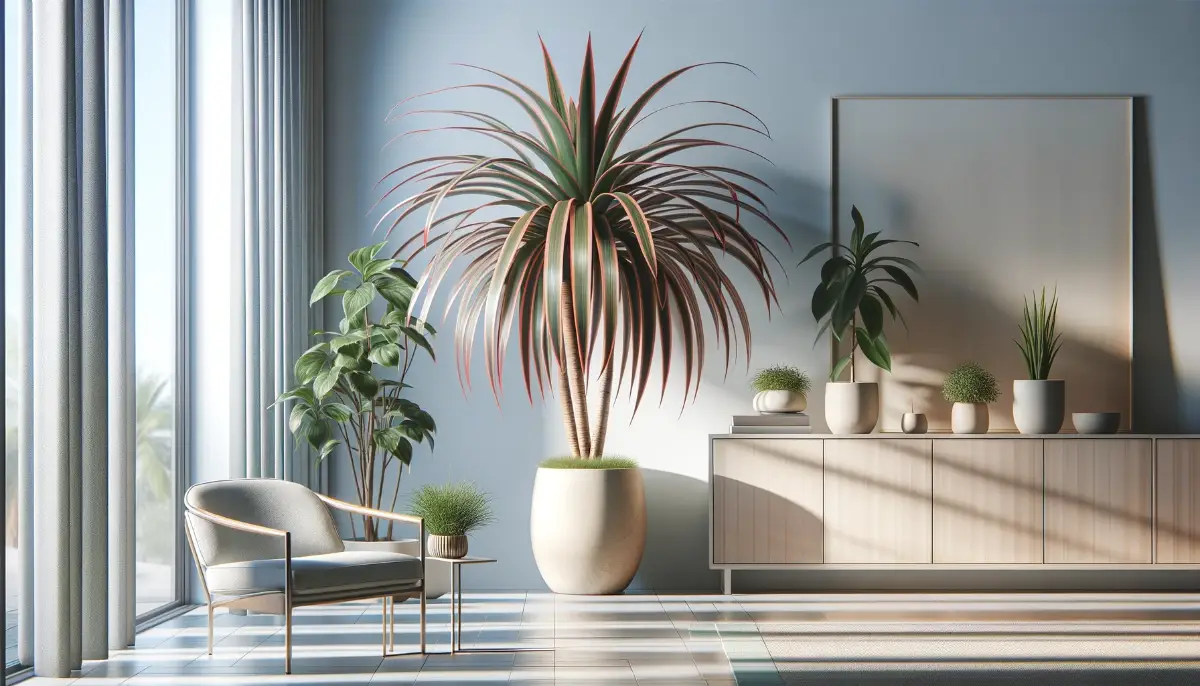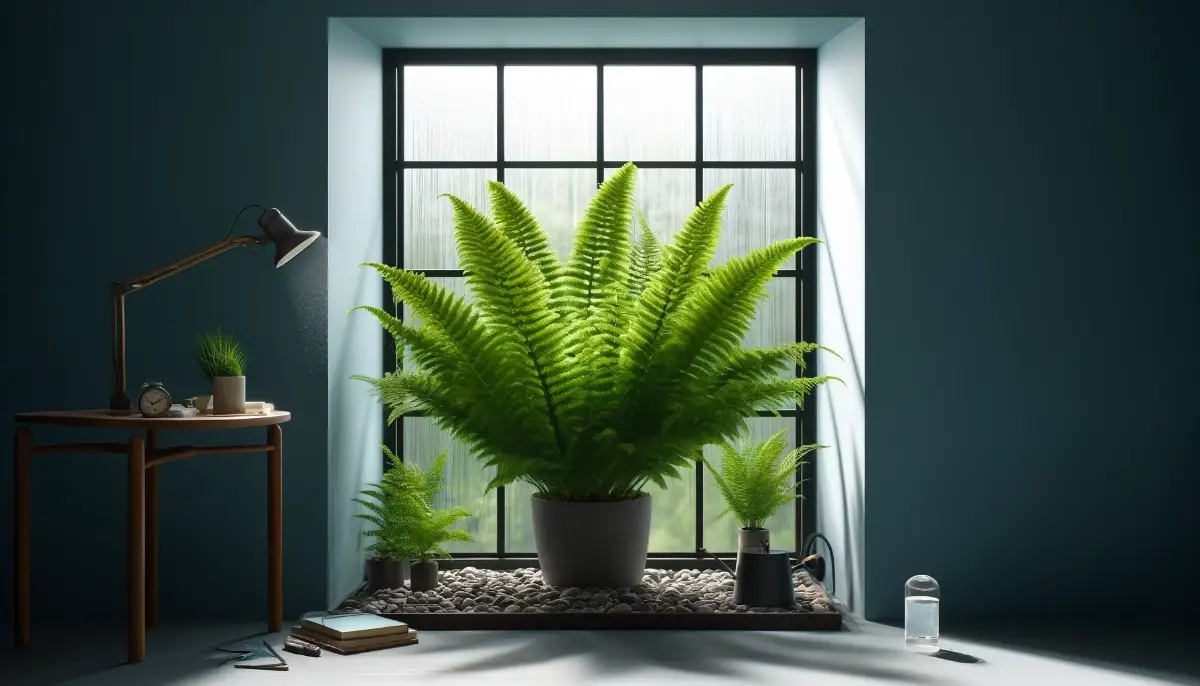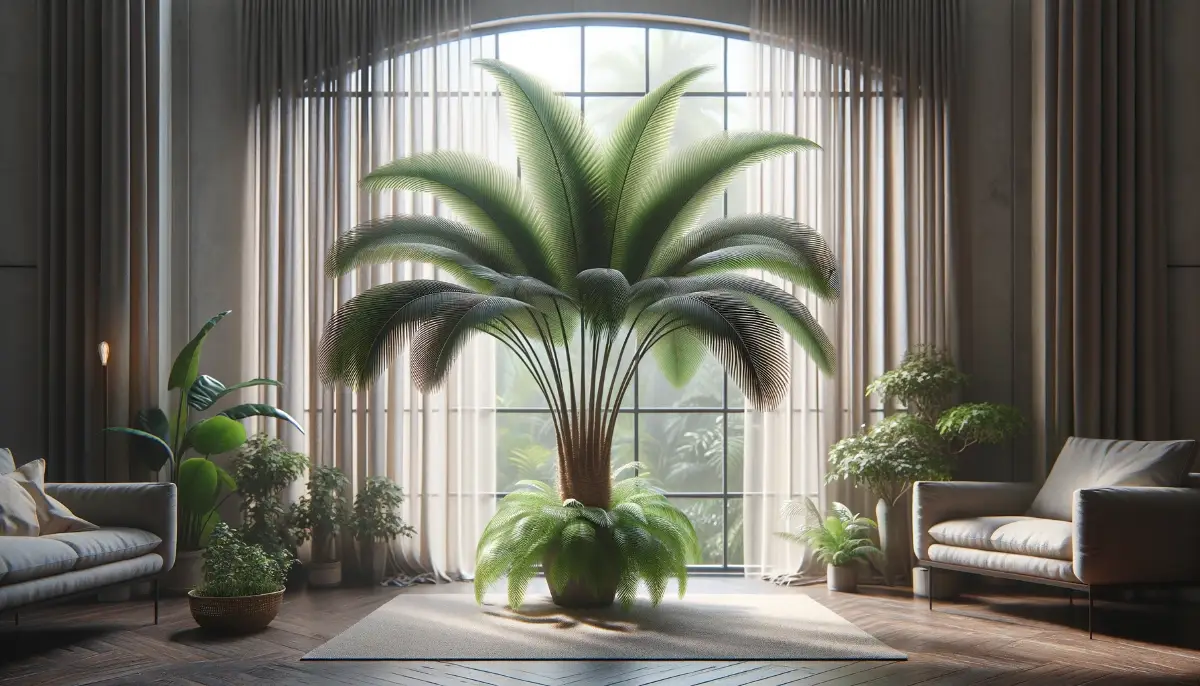Dracaena, a versatile and popular houseplant, is cherished for its striking, sculptural forms and resilient nature, making it a favorite for both home and office settings. These plants belong to a diverse family that includes a variety of species, each distinguished by long, arching leaves marked with vibrant streaks of color, ranging from cream to red.
Dracaenas are not only aesthetically pleasing but also known for their air-purifying qualities, making them especially valuable for improving indoor air quality. They are relatively easy to care for, thriving in indirect light and requiring minimal watering, which suits those new to indoor gardening as well as seasoned plant enthusiasts.
This adaptability to a range of environments and minimal care requirements underline their popularity and make them an excellent choice for enhancing indoor spaces with greenery.
Common Varieties of Dracaena
Dracaena plants boast a diverse range of species, each with unique characteristics that make them a popular choice for indoor gardening. Here are some common varieties of Dracaena:
Dracaena Marginata (Dragon Tree): Recognized by its narrow leaves with red edges, this variety is known for its tree-like shape and can grow quite tall. It’s adaptable to various light conditions but prefers bright, indirect light.

By Forest & Kim Starr, CC BY 3.0, Link
Dracaena Fragrans (Corn Plant): Often seen with thick, woody stems and lush green leaves that feature a yellow or light green stripe down the center, the Corn Plant resembles a corn stalk. It is appreciated for its ability to thrive in lower light conditions and its air-purifying qualities.
Dracaena Reflexa (Song of India): This variety is distinctive for its glossy green leaves that have yellow or white stripes. It’s more compact compared to other Dracaenas and does well in bright, indirect light.

By KENPEI, CC BY-SA 3.0, Link
Dracaena Trifasciata (Snake Plant): Formerly known as Sansevieria, this variety stands out with its upright, sword-like leaves that are green with gray or silver horizontal stripes. It is extremely drought-tolerant and can thrive in low light conditions, making it one of the easiest Dracaenas to care for.

By Mokkie, CC BY-SA 3.0, Link
Dracaena ‘Lemon Lime’: Offering a vibrant touch with its sharp green and yellow striped leaves, this variety adds a burst of color to any room. It requires similar care to the Dracaena Fragrans and enjoys moderate to bright indirect light.
Each variety of Dracaena has its own specific care needs, mainly varying in light and watering requirements, but all share a common ease of maintenance that makes them suitable for indoor environments.
Light Requirements
Dracaena plants thrive best in conditions where they can receive plenty of bright, indirect sunlight. While they are adaptable and can tolerate lower light conditions, their growth may slow down, and their vibrant colors might become less pronounced in such environments.
Direct sunlight, however, should be avoided as it can cause the leaves to burn, leading to blemished foliage. Ideally, placing a Dracaena near a window that is covered with sheer curtains or in a well-lit room without direct exposure to the sun is perfect for maintaining its health and vibrant appearance.
This balance ensures that the plant gets enough light to sustain its growth without risking damage from the harsh rays of direct sunlight.
Watering Needs
Dracaena plants require careful watering to maintain their health and appearance. The key is to ensure that the soil is kept evenly moist but never waterlogged. Overwatering can lead to root rot, which is a common issue with these plants. It is best to allow the top 50-75% of the soil to dry out before watering again.
This encourages the roots to grow stronger as they reach down for moisture, promoting overall plant health.
When watering, use room temperature water and ensure it drains properly through the pot. Dracaenas are sensitive to fluoride, which is commonly found in tap water, so using filtered or distilled water can prevent the leaf tips from browning.
During the winter months or in cooler climates, reduce the watering frequency as the plant’s growth slows down, but keep the soil slightly moist.
Regularly check the moisture level of the soil and adjust your watering schedule based on the season and the environment the plant is in. This approach helps mimic the natural habitat of Dracaena and contributes to a thriving plant.
Temperature and Humidity
Dracaena plants prefer a stable temperature range typical of indoor environments, making them ideal houseplants. They thrive best in temperatures between 65-85°F (18-29°C). It’s important to protect them from extreme temperature changes, which can stress the plant.
Dracaenas are particularly sensitive to cold drafts and sudden drops in temperature, so it’s advisable to keep them away from entryways and air conditioning vents during the colder months.
In terms of humidity, Dracaenas do well in moderate to high humidity environments, similar to their native tropical settings. While they can adapt to lower humidity levels found in most homes, they benefit from occasional misting or the use of a humidifier to maintain moisture around their foliage, especially during dry winter months.
This added humidity helps keep their leaves healthy and vibrant and can prevent issues like brown leaf tips, which often indicate dry air conditions.
Dracaena Soil Requirements
Dracaena plants require well-draining soil to prevent water from pooling at the roots, which can lead to root rot. A mixture that includes perlite or coarse sand can enhance drainage, making it ideal for these types of plants.
Additionally, using a soil mix that is slightly acidic to neutral (pH 6.0 to 7.0) is beneficial for Dracaena’s overall health.
For potting, choose a container with drainage holes to allow excess water to escape, which is crucial to avoid over-saturation of the soil. This setup mimics the natural drainage these plants would experience in their native habitats, helping to maintain the right moisture balance and prevent water-related issues.
Organic Fertilization Practices
For organic fertilization practices, Dracaena plants benefit significantly from gentle, organic approaches due to their moderate feeding needs. Here are some recommended practices:
Type of Fertilizer: Use an organic, all-purpose plant food that is balanced and gentle. Products such as fish emulsion, seaweed extract, or compost tea are excellent choices as they provide nutrients slowly and safely without the risk of chemical burn, which can occur with synthetic fertilizers.
Fertilizing Frequency: During the growing seasons of spring and summer, fertilize Dracaena once a month. These plants have a slower growth rate and thus require less frequent feeding compared to other houseplants.
It’s important to dilute the organic fertilizer to about half the recommended strength to avoid overfeeding, which can harm the plant.
Winter Care: In the fall and winter months, reduce fertilization as the plant’s growth naturally slows down. Overfeeding during these dormant periods can lead to nutrient buildup in the soil, which may harm the plant.
Application Method: Apply the diluted organic fertilizer to moist soil to prevent root burn and ensure that the nutrients are well-absorbed. Always follow the specific instructions provided on the fertilizer packaging for the best results.
By following these organic fertilization practices, you can help your Dracaena thrive while maintaining a natural and safe indoor gardening approach.
Propagation Techniques
Dracaena plants can be propagated using several techniques, each suited to different varieties and gardener preferences. Here are some common methods:
Stem Cuttings: This is the most popular method for propagating Dracaenas. To do this, cut a segment of the stem around 4-6 inches long, ideally with a few leaf nodes. Allow the cutting to dry for a couple of days until the cut end callouses over, which helps prevent rot.
Plant the cutting in a pot with well-draining soil and keep the soil moist but not waterlogged. Rooting typically occurs within a few weeks.
Air Layering: This method is particularly effective for taller Dracaena species that have lost their lower leaves and become leggy. Make an upward cut about one-third through the stem where you want roots to form, and insert a small piece of wood or plastic to keep the cut open.
Wrap the area with moist sphagnum moss and enclose it in plastic to retain moisture. Roots should develop within a few months, after which you can cut below the rooted area and pot it as a new plant.
Root Division: This method is suitable when repotting Dracaena, especially for clump-forming varieties. Carefully remove the plant from its pot and gently divide the root ball into smaller sections, ensuring each section has adequate roots and shoots.
Pot each division into fresh soil and care for them as individual plants.
Each of these methods has its benefits and can be chosen based on the condition of the plant and the desired speed of propagation. Patience is key, as Dracaenas can be slow to root and grow, especially in less than ideal conditions.
Pruning and Maintenance
Pruning and maintaining Dracaena plants are important aspects of their care to ensure they remain healthy and aesthetically pleasing. Here’s how you can effectively prune and maintain your Dracaena:
Pruning for Health and Shape: Dracaena benefits from regular pruning to remove any dead or yellowing leaves, which helps the plant conserve energy. This also includes cutting back any leggy stems to promote bushier growth and maintain a desirable shape. Pruning is best done in the spring or early summer when the plant is actively growing.
Technique: Use clean, sharp scissors or pruning shears to make cuts just above leaf nodes or along the stem. This encourages new growth from the cut points. If you’re dealing with a taller Dracaena, you can cut the main stem to your desired height, and new shoots will typically emerge near the cut.
Maintenance Pruning: Besides shaping the plant, regular maintenance pruning includes removing any dust that accumulates on leaves with a damp cloth. This not only keeps the plant looking fresh but also improves its ability to absorb light, which is crucial for its health. Additionally, inspect regularly for signs of pests or disease and treat promptly to prevent spread.
Post-Pruning Care: After pruning, it’s a good idea to water the plant and provide it with a light feeding to support new growth, especially if pruning is done during the growing season. This helps the plant recover and thrive after losing some of its mass.
By following these pruning and maintenance guidelines, your Dracaena will continue to grow robustly and retain its decorative appeal, making it a long-lasting addition to your indoor garden.
Repotting Guidelines for Dracaena
Repotting Dracaena plants is a crucial aspect of their long-term care, especially to ensure they have enough space to grow and to refresh the nutrients in their soil. Here’s a detailed guide on how to repot Dracaenas effectively:
When to Repot: Dracaena should be repotted every 2-3 years or when you notice signs like roots growing through the drainage holes or the soil drying out faster than usual. The best time to repot is during the spring or early summer, which gives the plant time to recover and grow actively post-repotting.
Choosing the Right Pot: Select a new pot that is 1-2 inches larger in diameter than the current one. Ensure the new pot has adequate drainage holes to prevent water accumulation and root rot. Using a slightly larger pot helps to encourage growth without giving too much space, which can lead to waterlogging.
Soil Selection: Use a well-draining potting mix designed for indoor plants. You can make your own mix using equal parts potting soil, perlite, and peat moss. This mixture ensures good drainage and aeration, providing the right environment for roots to thrive.
The Repotting Process:
- Gently remove the plant from its current pot, being careful not to damage the root system.
- Shake off the old soil and inspect the roots. Trim any that are dead or overly long.
- Place some fresh potting mix at the bottom of the new pot and position the plant so that the top of the root ball is about an inch below the rim of the pot. This ensures enough room for watering.
- Fill around the roots with more potting mix, gently tamping down to remove any air pockets.
- Water thoroughly after repotting to help settle the soil and give the plant a good start in its new container.
Aftercare: Keep the repotted plant in a location with indirect light and avoid fertilizing for about a month to allow the plant to settle. Maintain your regular watering schedule, adjusting as needed to accommodate the fresh soil’s moisture retention.
By following these guidelines, you can help ensure your Dracaena thrives after being repotted, providing it with a refreshed environment conducive to growth.
Dealing with Common Pests and Diseases
Dracaena plants, like many houseplants, can be susceptible to a range of pests and diseases. Here’s how to identify and deal with some of the most common issues:
Pests
- Spider Mites: These tiny pests appear as small dots on the underside of leaves, often with visible webbing. They cause the leaves to turn yellow and drop prematurely. To combat spider mites, wipe the leaves with a damp cloth regularly and use insecticidal soap or a neem oil solution to treat infestations.
- Scale: These are small, brown, hard-shelled insects that attach themselves to the stems and leaves, sucking the sap and weakening the plant. Scale can be treated by manually removing them with a soft brush dipped in soapy water or using an organic insecticide .
- Mealybugs: These pests look like small cottony patches on the leaves and stems. They suck sap from the plant, leading to weakened growth and yellowing leaves. Mealybugs can be removed using a cotton swab dipped in rubbing alcohol or treated with insecticidal soap.
Helpful Articles:
How to Manage Pests and Diseases in Your Indoor Garden
Scale Insects: How to Spot, Treat, and Prevent Them Naturally
Natural Methods to Control Mealybug Infestations
Diseases
- Root Rot: This is a common issue caused by overwatering, where the roots of the plant start decaying. Symptoms include soft, brown roots and wilting leaves. Prevent root rot by ensuring your pot has good drainage and by letting the soil dry out between waterings. If root rot occurs, you may need to repot the plant into fresh soil after removing the affected roots.
- Leaf Spot: Caused by fungal or bacterial infections, leaf spot appears as discolored spots on the leaves. Ensuring good air circulation around the plant and avoiding overhead watering can help prevent leaf spot. Infected leaves should be removed and discarded, and fungicidal sprays may be necessary for severe cases.
Regular monitoring and maintaining a clean environment are crucial for preventing these issues. Early detection and treatment can help keep your Dracaena healthy and thriving.
FAQs for Dracena Plant
How often should I water my Dracaena plant?
Water your Dracaena when the top 50%-75% of the soil is dry. Avoid overwatering as it can lead to root rot.
What type of light is best for Dracaena?
Dracaena plants thrive in medium to bright indirect sunlight. Direct sunlight should be avoided to prevent leaf burn.
Do Dracaena plants need special fertilizer?
Use a balanced, water-soluble fertilizer diluted to half strength once a month during the growing season (spring and summer). Avoid fertilizing in the winter.
How do I prune a Dracaena plant?
Prune by cutting back the stems to encourage bushier growth, usually in the spring or early summer. Remove any dead or yellowing leaves as needed.
Can Dracaena plants improve indoor air quality?
Yes, Dracaena plants are known to remove toxins from the air, improving indoor air quality.
Why are the tips of my Dracaena turning brown?
Brown tips can be caused by low humidity, fluoridated tap water, or over-fertilization. Increasing humidity, using non-fluoridated water, and reducing fertilizer can help.
Is Dracaena toxic to pets?
Yes, Dracaena leaves are toxic to cats and dogs. Ingestion can cause vomiting and other digestive issues.
How do I repot a Dracaena plant?
Repot your Dracaena every 2-3 years during spring or early summer into a slightly larger pot with fresh, well-draining soil.
What are common pests that affect Dracaena plants?
Common pests include spider mites, scale insects, and mealybugs. Regular cleaning of leaves and appropriate insecticides can manage these pests.
How can I propagate Dracaena?
Propagate Dracaena by stem cuttings or air layering. Stem cuttings can be rooted in soil or water, while air layering involves inducing roots while the stem is still attached to the parent plant.










